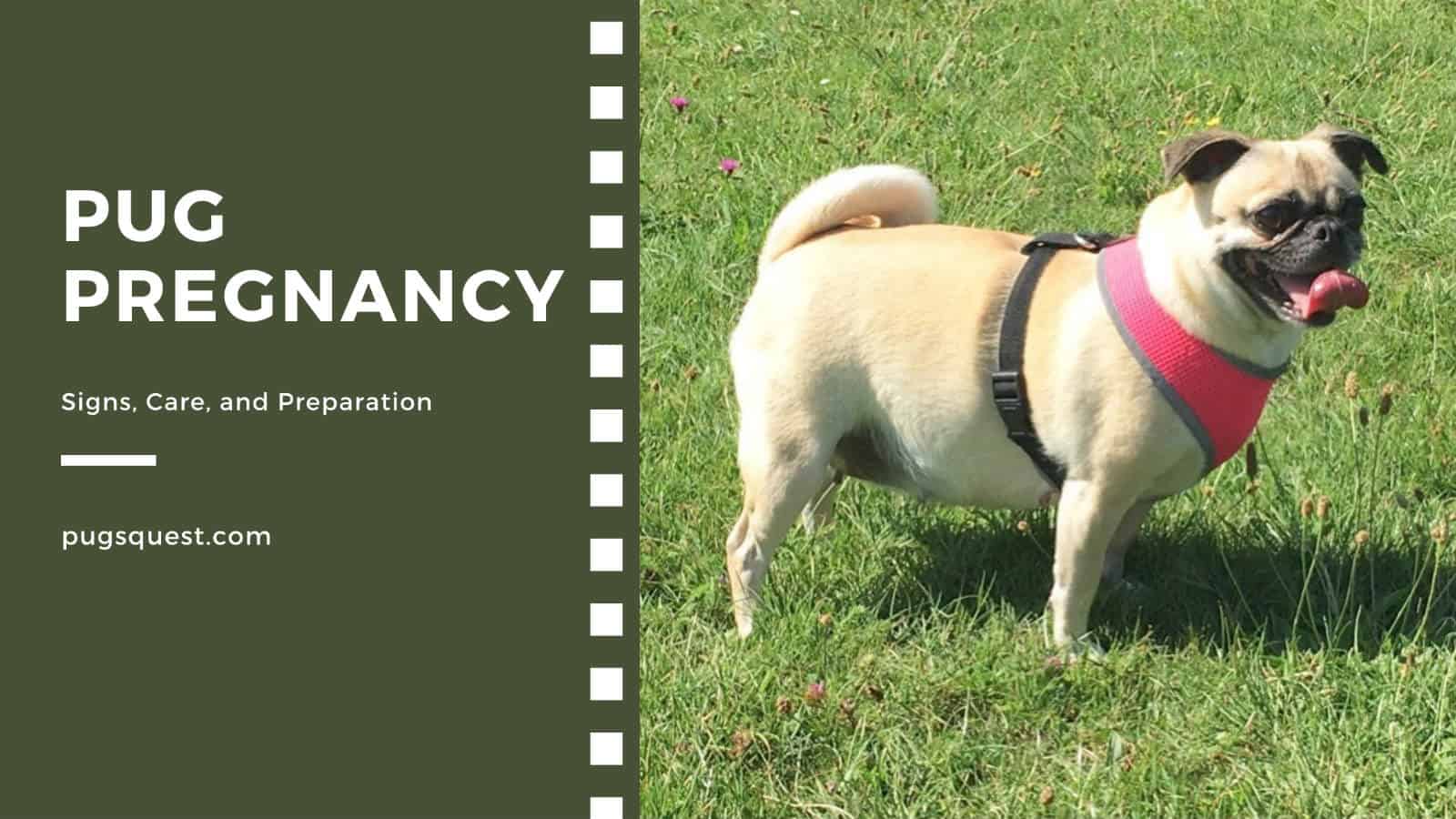Whether you’re planning to breed your pug or you’ve been hit by an unexpected pregnancy, we’re ready to give you an expert lowdown.
By equipping yourself with the information you need to care for mumma pug, you’ll give her and her puppies the best chances.
In this article, we’re going to walk through a pug pregnancy from start to finish. We’ll cover everything from gestation to care, labor, and delivery.
If you’ve got pregnant, or soon to be a pregnant pug, it’s time to get ready for some cute new arrivals.
How Long Will My Pug be Pregnant For?
The gestation period of a pug is very similar to other dog breeds.
Anything between 58 and 68 days is considered typical, with the average length falling at 63 days from conception to delivery.
Pug pregnancies may be relatively short but they go through stages like any other.
It’s also important to be aware that some pugs deliver earlier than others. By week eight you should already be prepared for labor.
Have all your equipment ready to go, monitor mom’s behavior, and keep checking her temperature.
How Can I be Sure That My Pug Is Pregnant?
Pugs show signs and symptoms of pregnancy but it’s not always easy to know for sure if your pet is pregnant.
The best way to get to the bottom of this mystery is to visit your vet for diagnostic testing. If she is pregnant, congratulations. It’s time to get ready for puppies.
The gestation period for pugs is relatively short when compared to humans.
Over the next few weeks, you’ll notice lots of changes in mamma pug. Let’s delve into the 63 days of gestation in some more detail.
Week 1 – Conception
- Care for mamma pug as normal
- Usually no signs
- Possible mild nausea and decreased appetite
- Some vomiting or discharge is normal
Week 2 – Cell development. Embryo moves to the uterus.
- Continue with her normal diet and exercise as normal
- She might be more tired than usual
- You might notice slight swelling of the belly and nipples
- Possible continued nausea and sickness
Week 3 – Fetus development (approx. 1 cm).
- Still no need to change her routine
- Mamma pug might be hungrier and sleepier than usual
Week 4 – The fetus is shaped like a very small pup with spinal and facial features (1.5 cm).
- This is the riskiest time for miscarriage so start making some changes to mamma’s routine
- Limit intense exercise or overexertion of any kind
- Ask your vet about a change in diet and nutritional supplements
- Nipples may be swollen and hang down as they are filled with colostrum
- distended tummy and clear discharge is normal
- nesting behaviors
Week 5 – Fully formed, small fetuses with paws, claws, and whiskers. It is not possible to gauge the sex.
- Mom pug will gain weight (about 10% of her normal body weight) and need more food.
- She may get tired very easily
- She will probably want to stay at home and be less social
- She may retreat to a quiet, comfortable spot
- You can opt for a scan to determine the sex and see how many puppies are arriving
Week 6 – Mamma pug will start to show and get visibly bigger by the day. The puppies are now developing their own unique markings.
- Nipples will darken
- Increased appetite
- Consider adding puppy food and nutritional supplements to your pregnant pug’s diet
- Help mamma pug with nesting. Provide a warm, quiet, and comfortable space to give birth
Week 7 – The pregnancy has reached its 42nd day. The puppies are almost fully developed.
- Hair loss to be expected in preparation for birth
- Increase mom’s food intake
Week 8 – Critical week. Some pugs give birth prematurely so be prepared for early labor. You might even see the puppies moving in mom’s belly.
- Mom will be demonstrating nesting behavior
Week 9 – Time to give birth!
- Be ready to help your pregnant pug when she does into labor.
How Many Puppies Should I Expect?
Much like other breeds, pugs have multiple puppies with each litter. Pugs average between four and six pups with each litter.
But remember, this is just an average. You might want to opt for a diagnostic ultrasound scan to identify how many puppies are growing.
If you’re leaving things as a surprise, be prepared for quite a range. Any number of puppies, from as few as one to as many as nine is possible.
The number of puppies will impact labor. A large litter can place a lot of strain on the mother and a cesarean may be needed.
Ask your vet for more information. They will be able to give you their recommendation and advice, with your pug’s best interests at heart.
How Can I Help My Pregnant Pug?
As a pug owner, it’s only natural to be concerned about her health during pregnancy. You love your pet to bits and she’s going through a big step.
Whether it’s her first pregnancies, or she’s had litters before, there are simple steps you can take to keep mamma comfortable.
1. Nurture her with nutrition
Make sure your pregnant pug is getting a sufficient and nutritious diet. Pregnant pugs eat a lot.
Expect a marked increase in her appetite and offer her larger, more frequent, portions of food accordingly.
Usually, the largest appetite increase is observed at three to four weeks.
You’ve probably been warned against overfeeding pugs due to their predisposition to become obese.
But do not deny a pregnant pug their much-needed calories. Some pugs will eat up to 50% more during pregnancy.
She will be craving sustenance to keep her pups growing and should be allowed to eat according to her appetite.
Something owners can do is control the quality of the food they offer a pregnant pug. This is an important time to keep things healthy.
Give her foods jam-packed with nutrients. If you haven’t already, now’s the time to experiment with home and raw cooking.
Avoid supplements at this time. This is a hotly debated issue. Some people swear by the benefits of nutritional supplements for pregnant pugs, calcium in particular.
But research has suggested that doing so can actually cause undue harm, increase risk factors, and cause difficult deliveries.
It’s best to air on the side of caution during this important time in your pug’s life. Focus on healthy foods and plenty of water.
2. Provide safety and comfort
Pregnant pugs might start to crave quiet time alone. She will need space to start nesting.
Let her spend as much time as she needs preparing her nest and resting before the labor. You might want to invest in a comfortable bed and soft blankets.
Set up a cozy corner away from any busy thoroughfares but not so isolated that she will feel lonely, nervous, or stressed.
If you have other dogs, gauge mamma’s behavior. If she starts to seem nervous, surround her nest with baby gates to offer her extra privacy and comfort.
Separate mamma pug from the sire if living under the same roof. This should be done at around the five-week stage.
He can rejoin mom and the litter once the puppies are a bit older in a safe, supervised environment. Around the 4 week mark is just right.
3. Maintain an appropriate exercise regime
Though exercise is still important for a pregnant pug, it must be moderated. Overexertion could be extremely harmful.
Ask your veterinarian if they would recommend any restrictions for your pug in particular.
In general, it’s best to continue walking her at a gentle pace to avoid muscle soreness and keep her fit and nimble.
The most important thing is to steer her clear of jumping and strenuous activities. Don’t let her jump from the sofa for example.
As the birth approaches her mobility is likely to deteriorate and it’s okay to cease walks altogether.
How To Help A Pug Deliver Her Puppies
The big day has arrived. By now it’s a good idea to have had a final check-up with your vet.
They will be able to tell you whether your pug is suitable for a home birth or if she will require a cesarean section in practice.
If you’re going ahead with natural birth, it’s time to get prepared. Prepare a quiet corner with a whelping box.
There are many tutorials online that will help you prepare a suitable birth environment. Check out this one below:
In general, a whelping box usually consists of a large box with a comfortable dog bed placed inside.
One side of the box can be cut out in order to give you access and help mom out if needed. Clean newspapers are the perfect bedding and easily replaceable when dirty.
Make sure you have everything you need for when labor arrives. Be prepared early, as some pugs go into early labor.
Keep supplies at close reach and arrange for someone to help you once the labor starts.
The following items are labor must-haves:
- Cleaning spray
- A thermometer
- Sterilized thread
- A suction bulb
- A heating pad
- A small dropper
- Lots of clean towels
- Pup milk substitute
- Surgical gloves
- Round-tipped, sterile scissors
- Petroleum jelly
Take mom’s temperature twice daily from day 55 onwards with a canine rectal thermometer.
She is ready for birth within 24 hours when her temperature falls below 100 degrees. It’s action time.
Trust mamma pugs instincts and get ready for the pitter-patter of tiny paws.
Possible Pug Labor Complications You Should Know
Pug birth is a speedy business. Once contractions start, your pug will be ready to give birth within ten minutes.
It is typical of Brachycephalic breeds to give birth to one or two pups right off the bat.
Don’t be alarmed if the remaining pups take a bit longer. It’s totally normal.
If there’s no subsequent movement after two hours, that’s the time to contact your vet. But still, it’s not time to panic.
Pug labor can actually take between three and twelve hours. As brachycephalic dogs, pug’s are vulnerable to some complications. These include:
1. Dystocia
This just means a difficult delivery. It could be due to a particularly large puppy or a mother’s particularly small pelvis.
Unfortunately, pug physiology is the perfect package for a dystocic pregnancy. Pups have large heads and mother’s small pelvic structures.
Your pug may need a cesarean to mitigate this risk so make sure you get her checked out by a veterinarian prior to going into labor.
If your dog starts showing signs of severe discomfort during labor, call your veterinarian immediately.
This is also referred to as stalled labor. Sometimes a pregnant pug’s uterine muscles will prevent her from delivering her pups naturally. She may need a c-section.
If she starts shivering or trembling there may be serious complications. It’s time to call your veterinarian immediately.
3. Infection
Reproductive tract infections are not uncommon. It is normal for dogs to discharge a dark green, bloody fluid after puppy number one, but if it happens before delivery it’s advised that you contact your vet.
Reproductive tract infections usually occur as a result of poor hygiene during pregnancy, so try to keep operations as clean as possible throughout the gestation period.
Using unscented, dog-friendly hygiene products throughout your pug’s pregnancy is the best way to avoid her contracting an uncomfortable infection.
Pug Pregnancy: Last Words
If you’re reading this article, puppies are probably on their way. You’re now equipped with all the information you need to help mamma pug deliver her puppies safely.
Pregnant pugs will need some TLC before giving birth, so treat her like a princess and await some seriously cute puppies.
image source: Instagram 1 & 2


